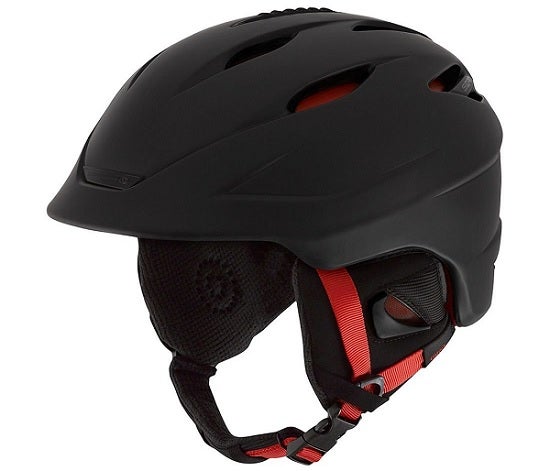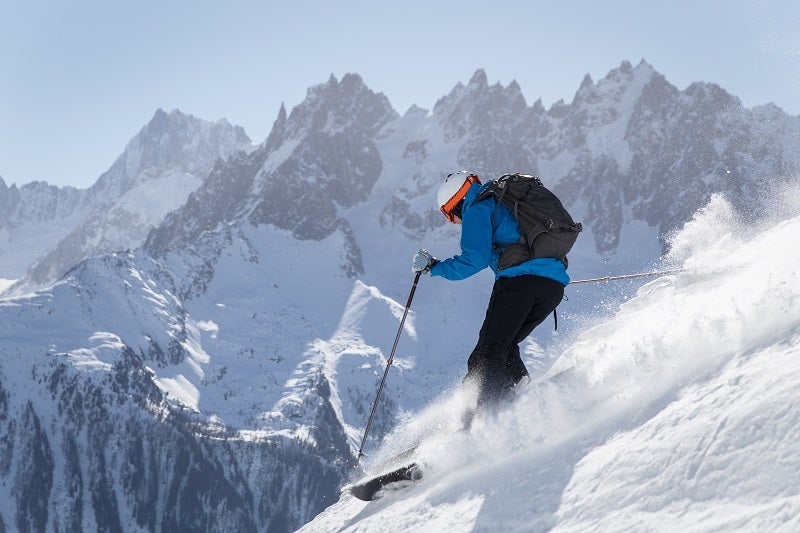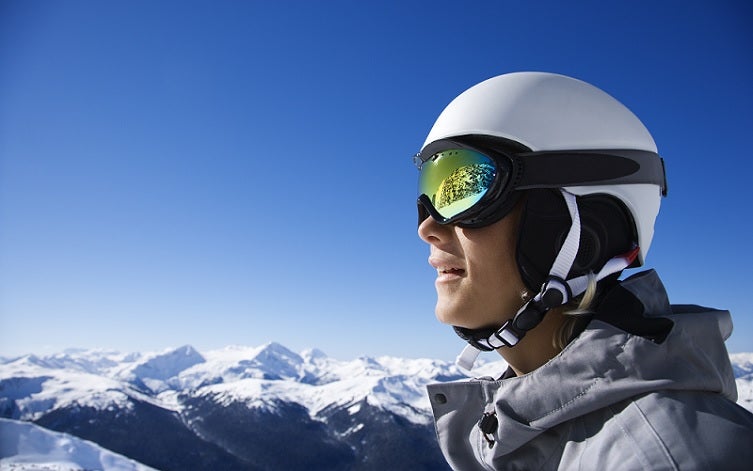
Our Editors independently research, test, and rate what we feel are the best products. We use affiliate links and may receive a small commission on purchases.
The top ski helmets are not only warm but so comfortable you will forget you are wearing a helmet. There really is no good reason for not wearing a helmet when skiing.
No matter what your budget is, there is a helmet that will meet your needs. Even the cheaper models offer good protection and are plenty warm.
And if ski helmets with audio is important to you, the Smith Optics have the “Skull Candy” option available.
Best Ski Helmets
For more of my ski gear recommendations, have a look through these popular Outside Pursuits guide links: Ski Gloves, Ski Jackets, Ski Pants.
Quick Answer: The 7 Best Rated Ski Helmets
- Giro Seam Snow Sports Helmet
- Smith Vantage MIPS Snow Helmet
- Oakley Mod 5 MIPS Ski/Snowboarding Helmet
- Bolle Visor Premium MIPS Helmet
- Lucky Bums Snow Sports Helmet
- Smith Optics Holt Snow Sports Helmet
- POC Fornix Lightweight Ski Helmet
Our reviews of the top rated ski helmets with our comparison table and buyers guide will help you choose the right helmet for you.
Ski Helmet Reviews
Note: All the helmets reviewed have met required safety standards.
Best Mens Ski Helmet
#1 Giro Seam Snow Helmet
- Shell: In-Mold construction
- Visor: No
- Weight: 16oz
- Ventilation: 12 Adjustable vents
- MIPS: Available
First off, I have to say that the Giro Seam is my every-day ski helmet. You’re about to learn why these helmets totally kick ass.
A dial lock adjustment with floating internal suspension means that the helmet adjusts to fit your head like a glove with zero pressure points.
I wear this helmet 7-8 hours a day for 100+ days a season (I’ve got well over 400 days in this helmet) … trust me when I say you’ll forget it’s there.
Well placed ventilation is controlled by an easy to access and operate slider. One large slider opens and closes all vents on the helmet and features a “halfway open” positive stop so I can have my vents partially open or closed without guessing.

Ear panels feature a removable foam piece (meant for a speaker system) and mesh panels.
I took out the speaker inserts and it’s about a million times easier to hear than any other helmet I’ve ever worn. Oh yeah, and it doesn’t sacrifice a bit of comfort or warmth.
All of the internal padding of the giro ski helmet is adjustable, removable, and washable. This is a serious plus for those of us who wear a helmet all day!
Goggle retention strap is a line snap closure – again, this means your goggles have no chance of going anywhere even if you take a massive digger.
Going one step above the design of most other helmets, however, the Giro Seam goggle retainer is elastic so it can easily fit over even the bulkiest setups.
Pro Tip: Go for the solid black or solid white look – it’s a great sleek and clean look that says “I know what’s up.”
There are 15 colors available so everyone should be able to find one to suite their style. Overall, I think the Giro Seam is the best ski helmet.
If you want the added safety features of MIPS technology, check out the Giro Range Snow Helmet for Men and the Giro Era MIPS Snow Helmet for Women.
Safest Ski Helmet
#2 Smith Vantage MIPS Snow Helmet
- Shell: Hybrid SL Shell Construction
- Visor: No
- Weight: 18.5oz
- Ventilation: 21 Adjustable vents
- MIPS: Yes
The newly redesigned Vantage helmet now features MIPS technology. If you are not familiar with it, it stands for Multi-directional Impact Protection System.
It’s a fancy way of saying it lowers concussion risk by reducing the rotation of your head in the event of an impact.
The shell is one piece injection molded shell features a Koroyd design exclusive to Smith that provides extra impact resistance. The result is a strong, lightweight impact resistant design at a good price.
Its an advanced protection system that allows the liner of the helmet to move independently of the shell. In the event of an impact, it reduces rotational forces on the head.
It has plenty of adjustability with their “Boa” fit system. The Boa fitting system is a fancy way of saying it uses a wheel that you turn to adjust the cables so it fits your head perfectly.

The ear muffs are very comfortable and warm while letting in sound allowing you to hear people talking to you easily.
The Vantage is a very light helmet (about 18 oz) and one the lightest of the helmets evaluated. Not only is it light is also has one of the better ventilation systems of the tested ski helmets with 21 vent openings.
The front vents can be opened or closed with a slider and the same with the back vents, while some of the lower vents are always open. The helmet is plenty warm, and the liner has a “Nanosilver” coating to prevent bacteria and odor buildup.
Being that Smith Optics also makes goggles as well, they have made the Vantage very goggle friendly. It features a unique snap design that secures the goggles while making it easy to remove them at the same time.
Naturally the helmet is designed especially for Smith Optics goggles but they work fine with other manufacturers as well.
Women’s Model: Smith Optics Vantage Womens Mips Ski Helmet
Best MIPS Ski Helmet
#3 Oakley Mod 5 MIPS Ski/Snowboarding Helmet
- Shell: Hybrid shell construction
- Visor: No
- Weight: 18oz
- Ventilation: Brim ventilation, adjustable vents
- MIPS: Yes
The Oakley Mod 5 is probably the most feature rich helmet on our list and one of the safest.
It has MIPS integration combined with a hybrid shell design with ABS and In Mold construction so it provides maximum protection in the event of a crash.
In addition to safety, the Mod 5 is one of the most comfortable ski helmets with its Boa fit system that conforms to your head. I have to say the goggle integration is the best I have seen, especially when paired with the Oakley Flight Deck goggles.
It has a MBS or modular brim system venting that allows warm air that comes off your goggles to flow up through the brim and out through a vent at the top of the helmet for fog free vision.
Plus it helps prevent ice forming on your goggles which can happen then the temperature really dips.
Adding to the feature list are the removable ear muffs and inner liner that can be washed so they don’t get stinky after a day shredding on the slopes!
Rounding out the features are the 8 adjustable vents and a chin strap that uses magnetic latching so it’s easier to use, especially when you have on ski gloves than the traditional clip in design.
While costing more than most of the helmets on our list, if you value your head the Oakley Mod 5 is unmatched!
You can save some money by forgoing the MIPS integration with the Oakley Mod5 Factory Pilot Headband.
Best Ski Helmet With Visor
#4 Bolle Visor Premium MIPS Helmet
- Shell: Injection molded outer shell
- Visor: Yes
- Weight: 19.5oz
- Ventilation: 6 Adjustable vents
- MIPS: No
Ski helmets with face shields are starting to become popular for good reason: convenience.
Instead of having a separate pair of goggles, they are built into the helmet. You just flip them up instead of having to remove the goggles and having one more thing to lose and keep track of.
The helmet shell is a one piece injection molded design for high strength and a EPS inner shell to absorb impacts.
The inner liner is hypo-allergenic and has wicking properties for warm weather skiing. It’s also removable so you can wash it.
The ear pads are not only removable for when it’s warm out they also have been designed to let sound in so you can hear. A novel concept!
There is an adjustable venting system so that you can regulate warmth for your head and the visor is mirrored to protect your eyes from UV rays and glare while providing excellent visibility. Bolle has a variety of lenses that you can swap out for the light conditions.
If you want, you can remove the visor and use your own goggles. They included a goggle strap if you want to use your own.
With the IAS fitting system you can get the perfect fit for your head regardless of the shape of your head. If you’re looking for the best ski helmet with visor, the Bolle is for you!
Best Budget Ski Helmet
#5 Lucky Bums Snow Sports Helmet
- Shell: ABS/EPS Outer shell
- Visor: No
- Weight: 18oz
- Ventilation: 6 Vents
- MIPS: No
This helmet is surprisingly feature rich and robust considering the price point they managed to hit with it. Why do I consider it feature-rich?
Dial lock style adjustment strap in the back of the helmet adjusts the internal suspension system nicely to help fit a wider range of head sizes and shapes.
Don’t forget to order the right size helmet, though, because the adjustment range is only minor. Goggle retention strap on the back side is a line snap style fastener.
This differs from many manufacturers because it means once you button your goggle strap in, it won’t come back out until you want it to! This is much handier than you might think at first glance.
Good design, Lucky Bums!

Unfortunately, the mesh vents on top do not open or close which is a major drawback for me – it means you’ll be comfortable in a narrower range of temperatures.
For most people this won’t be a problem, but if you’re a hard charger and won’t let up when the weather gets rough… you may want to consider adjustable vents.
Compared to the Smith helmet, I think this ski helmet has more useful features for the everyday skier or boarder.
For the price I would recommend this helmet in favor of the Smith Holt helmet as I believe they’ve included more intelligent features for the casual skier.
The Lucky Bums is the best budget ski helmet that doesn’t compromise on safety.
Pro Tip: Wear a thin beanie under the helmet when the mercury drops!
The helmet is available in a variety of colors, including black, blue, red, silver, light blue, light pink and a rather natty black with skull. Excellent value for money and comfortable to wear.
Most Comfortable Ski Helmet
#6 Smith Optics Holt Snow Sports Helmet
- Shell: Injection molded ABS shell
- Visor: No
- Weight: 19oz
- Ventilation: AirEvac ventilation, 14 Vents
- MIPS: No
Coming in squarely at the budget range of snow sports helmets, the Holt helmet by Smith is a solid choice for the new skier or budget minded boarder.
Lacking nothing in the safety and protection department, the helmet achieves a balance of function and price by minimizing extravagance in other areas.
Ear cups are solid foam – no perforated holes to help improve sound transmission, so you may have a feeling of “muffled” hearing.
Minimal adjustability makes the helmet a good choice only if you know you can return it (Not an issue with Amazon) before buying to ensure it fits your head shape (Smith helmets do not fit my head at all).
Adjustable air ventilation is a serious positive addition to this budget minded helmet. Goggle retention system in the back is nice but having the opening at the top of the goggle lock is a huge oversight.

As an instructor I’ve worked with many clients rocking this brain bucket and I can say that goggles love to pop out of the goggle lock on the back – it’s not as well designed as it could be but it is also one the warmest ski helmets I have ever worn!
“Skullcandy” speaker pockets are included so if your looking for ski helmets with audio then you’re in luck.
All in all, this ski helmet is relatively bland(other colors are available) but it works and I’ve worked with hundreds of people who are perfectly satisfied with it.
Pro Tip: Smith helmets are generally well suited to people with more rounded heads – my huge oval shaped dome never fits them.
Bonus Feature: The helmet can also be used in the summer for skate boarding by removing the insulation. At 19 oz the helmet is comparatively light for an injection molded helmet making it a good choice and comfortable to wear.
Best Ski Helmet For Women
#7 POC Fornix Lightweight Ski Helmet
- Shell: In-mold polycarbonate
- Visor: No
- Weight: 19.5oz
- Ventilation: 6 Vents
- MIPS: No
The POC Fornix is a skateboarder inspired design offering excellent protection with an ABS shell for impact protection and penetration resistance with POC’s VDSAP (Ventilated Double Shell Anti-Penetration system).
The interior has further protection with an EPS liner with an In-Mold design for shock absorption in the event of a crash. To keep your goggles from fogging, the Receptor BUG has goggle vents on the brim for airflow.
What good is a helmet if it’s not comfortable?
POC has you covered with a highly adjustment fitment system and also has removable ear muffs so you can wash them or for warm weather skiing. The liner is also removeable for washing.
For a bargain price you get a safe, stylish helmet available in 12 colors to suite your style! The POC Fornix is probably the best ski helmet under $150 that doesn’t sacrifice protection.
Ski Helmet Comparison Table
| Ski Helmet | Construction | Ventilation | Weight | MIPS | Rating | |
|---|---|---|---|---|---|---|
| Giro Seam Snow Helmet | In-Mold Construction ABS shell | 14 adjustable vents | 16oz | No | 4.7 / 5.0 | |
| Smith Vantage MIPS Snow Helmet | Hybrid - ABS front / In-Mold rear | 21 adjustable vents | 18 oz | Yes | 4.8 / 5.0 | |
| Lucky Bums Snow Sports Helmet | In-Mold Construction ABS shell | 11 vents | 22 oz | No | 4.3 / 5.0 | |
| Smith Optics Holt | Injection molded ABS shell | 14 adjustable vents | 19 oz | No | 4.5 / 5.0 | |
| Oakley Mod 5 MIPS Ski/Snowboarding Helmet | Hybrid - ABS front / In-Mold rear | 8 adjustable vents | 20 oz | Yes | 3.8 / 5.0 | |
| Bolle Visor Premium MIPS Helmet | Injection molded ABS shell | 6 adjustable vents | 20.5 oz | No | 4.6 / 5.0 | |
| POC Fornix Lightweight Ski Helmet | Injection molded ABS shell | 8 adjustable vents | 19 oz | No | 4.0 / 5.0 |
Author’s Expertise / Why You Should Trust Our Reviews
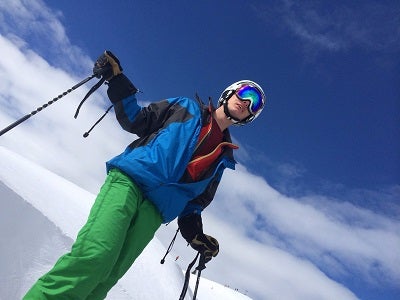
I started writing online for my own outdoor sports blog in 2010. Right out of the gate I landed opportunities to test gear for Road ID, Hydrapak, Wolverine, Helle Knives, Pearl Izumi, and GU Energy. Those were the days when growing a no-name blog was easy. Today niche blogging is a different story.
In 2012 I left Central Wyoming College with a degree in Outdoor Education and Leadership. Soon after, I was on a month-long expedition with the National Outdoor Leadership School’s Outdoor Educator Course which helps would-be outdoor guides ascend from “aspiring” to “inspiring”.
Between here and there I’ve participated in and spoken at length about outdoor pro-deal programs for companies like Patagonia, Smith Optics, Giro, Therm-a-Rest, Platypus, MSR, Columbia, and many more. I still work closely with tons of outdoor gear companies to review and analyze products. If you have a product opportunity you’d like to discuss, please review my guidelines and contact me here.
After several seasons of guiding backpacking trips and working as a certified Alpine Ski Instructor at Deer Valley Resort in Park City, UT for several seasons, I had to move on. As any educator will tell you – teaching doesn’t pay the bills very well.
In 2016 I began building my freelance writing career as readers and other bloggers reached out to me for help with technical outdoor sports content strategy for online businesses. Within weeks I was overloaded with requests for freelance writing and my new career blossomed.
2018 saw the launch of Hike With Less, my ultralight backpacking partnership program with Dustin Walker.
How to Choose the Best Ski Helmet
- Types of Helmets
- Construction
- Fit and Comfort
- Warmth and Ventilation
- Weight and Bulk
- Goggle Compatibility
- Helmet Style
- Helmet Features
- Best Ski Helmet Brands
- FAQs For Ski Helmets
- Final Thoughts
Types of Ski Helmets
There are several different types of helmets. Most recreational skiers opt for the “half shell” which covers only part of the head. This means that detachable ear muffs are needed.
However, for maximum safety you can opt for a “full face” whole shell design where these are integrated. These are especially popular for small children and beginning skiers.
Half Shell: Essentially a half shell helmet covers the parts of your head where you have hair (or had it). Ears are covered only with a cushion of insulation and your face is exposed. This is by far the most common type of helmet for recreational skiers.
Full Face: This is basically like a full face motorcycle helmet and offers much more protection. It covers your head, down over the ears, and comes under your chin just leaving the nose and eyes uncovered for a helmet.
Full Shell: The full shell is basically the same as the half shell except that the ears are protected as well.
Safety and MIPS Integration
Ensure that any helmet you buy meets ASTM F2040 if you are buying from the U.S or European standard CE EN 1077. While children’s helmets are lighter than adults they also have to meet stringent safety standards.
Any helmet sold by a reputable reseller should meet these guidelines.
What is MIPS?
You may see helmets advertised with MIPS (Multi-directional Impact Protection) integration and wonder what that is. With the awareness of head injuries new technologies have been invented and probably the most widely adopted is MIPS.
MIPS in a nutshell provides extra protection by allowing the inner liner to move independently from the outer shell. This has the effect of reducing head movement in an impact.
You read more about the technology here at the MIPS site. The good news is the cost of MIPS is coming down and becoming available in more helmets every year. Adding MIPS integration to a helmet increases the cost and what the extra protection from your brain bucket is worth is up to you.
There are some competing technologies out there but none as widely adopted as MIPS. Either way, skiers win with better head protection. But in my book, spending and extra $30-$50 is worth it to me to prevent a possible brain injury!
Ski Helmet Construction
Construction methods the helmet is made from is going to the most important factor in safety, weight and of course cost.
Injection Molded
This is the tradition design for ski helmets and consists of a tough, hard shell from ABS (Acrylonitrile Butadiene Styrene) with a EPS foam liner that is glued to the shell of the helmet. While it’s a good design that is strong, it is also heavier than In-Mold construction. They are however, substantially cheaper and good for beginners and occasional skiers. Due to the construction method they tend to have a rounder shape.
In-Mold
Many newer ski helmets are made from an In-Mold or a Hybrid design. This style of helmet uses a polycarbonate shell with an EPS liner for light weight and strength. This comes at a higher price however but the design is superior in impact protection and ventilation.
Hybrid
The latest design now feature a hybrid design of ABS and In-Mold for lightweight and strength. These are the most expensive type of helmet but durability is increased over an In-Mold only design. If you can afford the extra cost (near $200 and up) these helmets are the way to go.
How to Evaluate a Ski Helmet
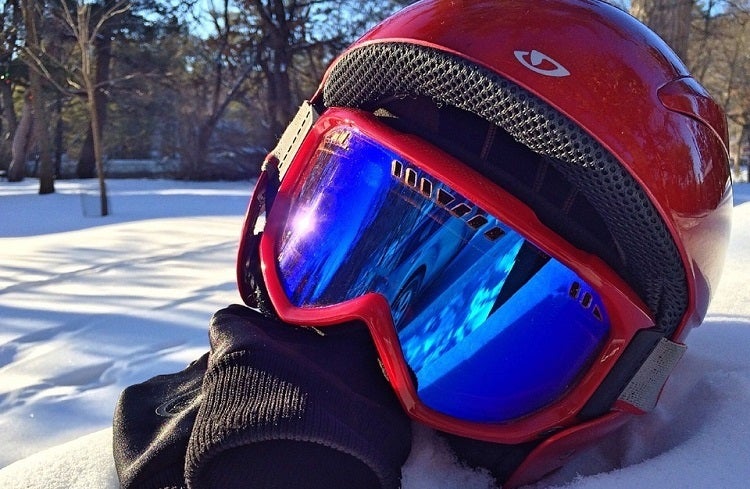
Fit and Comfort
Choosing the right fit of helmet for skiing and snowboarding is important, but this is easy to do. Measure the circumference of your head just about the eyebrows in centimeters.
Then consult the manufactures chart to choose the right size. If you are at the top end of a size go for the larger one. Allow a centimeter or so if you are going to wear a beanie or other type of hat.
As people have different shaped heads, manufacturers tend to make different shaped helmets or become known for making one of a particular shape.
Unfortunately, this can be difficult to know in advance until you try on the helmet. So be sure you are able the return the helmet if it is uncomfortable for your shape of head.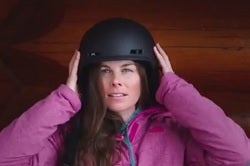
The helmet should of course be comfortable while not able to slide back and forth or from side to side and you should be able to buckle the helmet easily beneath your chin so that it fits snugly without cutting off your circulation or choking you.
You can then tighten and complete the fit of the helmet by using the adjustment system for the helmet so that it feels comfortable and snug.
You will know you have achieved this when the helmet is perfectly aligned and does not move easily when you try and move it around with your hands.
It goes without saying that you should never wear a helmet you do not feel comfortable in. You should not even notice you have it on after a few minutes. My Giro Seam helmet truly “fits like a glove”.
If you buy a helmet online make sure you have time to return it and get another one before you go skiing, especially important if you are going across country on a long ski trip.
You don’t want to have to purchase another helmet at the ski shop because you have an uncomfortable helmet.
If you have a ski shop nearby, try on a few different brands till you find the one you like, then buy it online for a cheaper price. Different helmets will suit different head shapes and there is never a one size fits all solution to buying a ski helmet.
If a helmet has the means to adjust the size from a scroll button at the back make sure that this is positioned so that it does not dig into the neck.
As everyone’s head is different, one make or brand of helmet will never work for everybody. It is best to try on several different helmets and choose one that you feel really comfortable in.
Warmth and Ventilation
I first time I wore a ski helmet I thought I would hate it! My wife at the time was insistent that I wear one, (this was after several notable people died in ski accidents), so I gave in and tried one. I was shocked! Not only was the helmet warm, I honestly forgot I had it on by the end of the first run.
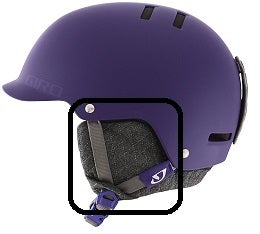
I cannot imagine it EVER being so cold that you would need to wear a hat underneath your helmet for warmth. You are more likely going to need to open the vents on the helmet because you are too hot than for protection against the cold.
This assumes of course that your goggles fit well with the helmet and do not leave a big gap between the helmet and the goggles for cold air to flow in.
Since half shell helmets only protect your ears with a cushion you need to be sure they fit snug over your ears keeping them warm. If they flop around or leave a gap your ears may get cold.
In cold weather, the snug fit of the helmet should not allow air to come between your head and the helmet.
I would advise you to buy a helmet that has adjustable vents allowing you to open or close them as needed.
Some of the best ski helmets allow you to finely adjustments of the vents, allowing you to get the exact amount of ventilation you want.
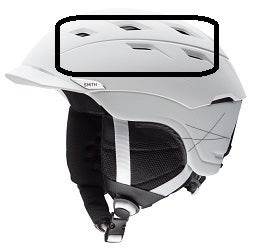
This will be especially important on warmer days; you will want to adjust the vents to cool you down. Make sure that the helmet you buy allows you to do this.
Another consideration in warm weather are detachable ear muffs, removing them is the best way to cool down.
When ear covers are loose and floppy they do not provide enough insulation. Half shell helmets tend to have less efficient ear coverage for this reason.
The best kind of ear muffs are those that are slightly tensioned. Keep in mind that some ear muffs will also reduce your ability to hear.
Weight and Bulk
In theory, a heavier helmet should mean better protection, however this has to be balanced with the need for buying one that you actually want to wear on your head.
Lighter weight helmets still have to meet stringent safety regulations and it is better to buy something you are comfortable in and actually want to wear.
An injection molded helmet generally weighs slightly more than one made from in molding.
The difference is not usually that noticeable however, but this is really a matter of personal preference. In general, a good ski helmet will weigh about a pound and somewhat lighter for children.
Goggle Compatibility
It is essential that the goggles you choose fit well with your chosen helmet. There should be no gap between the helmet and the top of the goggles.
Everything should fit seamlessly so if you’re going to try on a helmet at a ski shop, remember to take your goggles to check for proper fit.
One feature that is a must is a goggle strap in the back of the helmet to keep the goggles from slipping off the helmet when you push them up on the helmet.
You will especially appreciate this on the ski lift so you don’t have to worry about dropping them. Without it I would have lost mine long ago!
Helmet Style
Ski helmets come in a range of colors and designs. It can be tempting to go for a wonderful bold color only to realize later that this limits what you can wear with the helmet.
Choosing a style you want to be seen in will increase the likelihood you will always wear it. Safety is the most important factor when you buy a helmet but there is no reason you cannot look good at the same time!
Ski helmets now come in a vast array of colors so bear in mind that you may want the one you own to coordinate with the jackets and pants you intend to wear.
You may find a fairly neutral color is best if you only intend to buy a single helmet. This way your helmet will match most any color coat. You can always use a visor for added style, but remember that these do not work well with goggles.
Women’s Ski Helmets
There are now helmets that are marketed as Women’s ski helmets. The only difference is the availability of more feminine colors and style. If you go this route, be sure you’re not sacrificing comfort or fit for style.
There is no difference other than colors and maybe the liner, the safety features are the same. There are also some sizing differences in the women’s specific models.
Where they exist a link has been provided.
Helmet Features
Newer helmets offer a variety of features that make wearing helmet even more enjoyable.
Sound Systems: Helmets like the Smith Optics Vantage have an option to get a built in “Skull Candy” audio system. So when your shredding in the backcountry so can have on your favorite music playing. I personally have not used it yet but I can see the appeal.
Just keep in mind the risks when you have music playing, you cannot hear people trying to get your attention. This is especially important where trails merge. For this reason, I would only play music when skiing in the back bowls or you have the trail to yourself.
Camera Mount: I find it amazing how many people wear Go-Pros on their helmets while skiing. Although you can just stick on a camera mount, some newer models have it built in. In this way you don’t need to worry about it coming off. With Go-Pros costing hundreds of dollars, this is a good option.
Goggle Retainers: This is pretty much standard on any helmet nowadays. This is a clip of some sort on the back of the helmet that the strap is routed through so the goggle cannot slip off the helmet completely.
FAQs About Ski Helmets
Q: Do all ski helmets fit the same?
A: Absolutely not!
Personally I have a long, narrow head front to back. For me Giro helmets fit great! Smith helmets fit terrible.
Before you buy any helmet I always recommend trying on several models from different brands. Each brand seems to fit differently and once you find a brand you like you can choose which model of helmet has the features you want.
Q: Do I need adjustable vents?
A: Yes.
Helmet vents are an important part of staying comfortable on the mountain. If you buy a cheap helmet the vents are likely always open – they’re not adjustable. High end helmets tend to have adjustability.
With adjustable vents you can open or close them based on weather conditions. In fact my Giro Seam has always been good enough that even in spring season low altitude rain the water won’t get in if I just close the vents.
Managing temperature while skiing is always a challenge so having every tool at your disposal to do this is worth the money.
Q: Are built-in speakers a good idea?
A: Some helmets have speakers built in to the ears. They’re comfortable, enjoyable, and fun!
However, I would urge skiers to avoid them for safety. I can’t tell you how many times I’ve avoided a skier-skier collision by being able to hear what’s coming behind me.
By law (in some areas) and by responsibility in others, the uphill skier is responsible for collisions and colliding with a downhill skier can be punishable by law. However, that doesn’t seem to stop reckless skiers from careening down the hill and taking people out who are in their way, unfortunately.
When these assholes come slinging by inches from you, or that not-considerate-person shouts, “on your left” while passing you irresponsibly on a narrow cat track you probably want to know about it. Having “Sweet Child O’ Mine” blaring in your ear holes means you won’t pick up on those audio cues until it’s too late!
Q: What happens if I break my suspension system?
A: Getting the right fit on your helmet is always tricky. No matter what you do, you’ll likely not find a helmet that fits perfectly.
That can be solved, however, with an adjustable helmet suspension. Chances are you’ve seen them or worn them from a rental shop. They have those little dials on the back that you can turn to tight the helmet to fit your head!
Not all helmets have adjustable suspensions, however. Cheap helmets may just have padding inside with no adjustment.
If you manage to take a hard enough fall to break your suspension system the manufacturer is going to recommend that you replace the entire helmet. In fact you may not even be able to order or request a replacement strap!
One thing you can do is check to make sure the suspension really is broken. Some just pop out of their fittings inside the helmet and can be put back together just find after a hard fall.
Best Brands of Ski Helmets
When choosing the “best” ski there are several factors to consider: safety, style, fit and value. I think the following brands have done a pretty good job of nailing all of them:
Assuming that the brand you’re looking at is designed to safely handle a fall it’s probably just fine. However, some brands have new technology or more reliable helmets than others.
I would recommend the Giro MIPS helmets which haven an internal sleeve that can twist on a fall. This helps reduce instantaneous torquing of the neck and head which could otherwise result in serious injury.
Other brands like Smith have reliable proven helmets with similar torque-injury-preventing tech packed inside.
Giro – They focus on making quality helmets for most outdoor activities. My first Giro product was the Seam helmet. It is one of the most comfortable ski helmets out there. The new Montaro helmet with MIPS technology is worth your consideration.
Smith Optics – With a name like Smith Optics you might wonder why they would be on the list. They got their start making ski goggles back in the 60’s and now offer a full range of quality ski gear.
POC – Based in Stockholm Sweden, they got their start making ski equipment like goggles and helmets. They are a fairly new company, founded in 2004, they make some excellent ski gear
How We Researched
To come up with the top skiing helmets we researched a variety of sources for reviews such as REI, Backcountry, Moosejaw, EVO along with our own personal experience. We also consulted online magazines for product research and reviews to get as much unbiased information as we could.
With so much quality gear available, we had to narrow it down based on what we felt were the best options were for the price.
The author, Casey Fiedler was a full time ski instructor for Park City and The Canyons in Utah. To help narrow down the selection he used his personal experience along with recommendations from fellow ski instructors.
After extensive research, we came up with our list to help you choose the right pair for you.
Sources
Final Thoughts
All the helmets reviewed above will fit your needs for a safe and comfortable helmet. They all provide adequate warmth and ventilation and had a system in place to ensure a secure fit.
There was no problem with goggles misting up and the main differences were in the type of ventilation system used and the style.
The Lucky Bums Snow Sports Helmet seemed to be better for children and adults alike, but the Giro Seam Snow Sports Helmet has better thermostatic control and the Smith Optics Vantage Helmet was the best choice for color and style.
With the three we have reviewed, you cannot go wrong whichever one you choose and they all meet the criteria we have outlined in this article.
I hope this guide was helpful for finding a good ski helmet to fit your needs. If you want to comment or recommend a helmet I didn’t include, please use my contact form to get in touch.
New to skiing? See my beginners guide to skiing for tips and advice.
Have fun and enjoy your day on the slopes!

